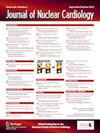射血分数改善的心力衰竭患者的心脏交感神经活动。
IF 3
4区 医学
Q2 CARDIAC & CARDIOVASCULAR SYSTEMS
引用次数: 0
摘要
背景:心衰(HF)伴射血分数改善(HFimpEF)患者的心脏交感神经活动特征尚不清楚。方法:对EF≤40%的HF患者在出院前及出院后6个月行超声心动图及123i -甲氧苄基胍显像检查,随访5.2(2.8 ~ 6.1)年。6个月时,EF≤40%的患者被分类为EF降低HF组(HFrEF)。同时,将EF为bb0 - 40%的患者归为HFimpEF组。结果:188例患者中,HFimpEF组78例(41.5%),HFrEF组110例(58.5%)。HFimpEF组在基线时心脏与纵隔(H/M)比HFrEF组好(分别为1.76[1.59-1.85]和1.64 [1.48-1.81];P = 0.011)。HFimpEF的预测因素包括缺血性心脏病(优势比[OR]: 0.45, 95%可信区间[CI]: 0.21-0.94, p = 0.034)、H/M比(OR: 1.02, 95% CI: 1.00-1.04, p = 0.032)和EF (OR: 1.14, 95% CI: 1.08-1.21, p)。结论:HFimpEF组的H/M比高于HFrEF组,提示心脏交感神经活性较低。H/M比值被确定为HFimpEF的独立预测因子。本文章由计算机程序翻译,如有差异,请以英文原文为准。

Cardiac sympathetic activity in patients suffering from heart failure with improved ejection fraction
Background
The characteristics of cardiac sympathetic nerve activity among patients suffering from heart failure (HF) with improved ejection fraction (EF) (HFimpEF) remain unclear.
Methods
Patients admitted for HF with an EF ≤ 40% who underwent echocardiography and 123I-metaiodobenzylguanidine scintigraphy before and 6 months after discharge were followed for 5.2 (2.8–6.1) years. At 6 months, patients with an EF ≤ 40% were classified into the HF with reduced EF (HFrEF) group. Meanwhile, patients with an EF of >40% were classified under the HFimpEF group.
Results
Among the 188 patients analyzed, 78 (41.5%) and 110 (58.5%) were categorized into the HFimpEF and HFrEF groups, respectively. The HFimpEF group had a better heart-to-mediastinal (H/M) ratio at baseline than did the HFrEF group (1.76 [1.59–1.85] vs 1.64 [1.48–1.81], respectively; P = .011). The predictive factors of HFimpEF included ischemic heart disease (odds ratio [OR]: .45, 95% confidence interval [CI]: .21–.94, P = .034), H/M ratio (OR: 1.02, 95% CI: 1.00–1.04, P = .032), and EF (OR: 1.14, 95% CI: 1.08–1.21, P < .001).
Conclusions
The HFimpEF group had a higher H/M ratio than did the HFrEF group, suggesting lower cardiac sympathetic hyperactivity. The H/M ratio was identified as an independent predictor of HFimpEF.
求助全文
通过发布文献求助,成功后即可免费获取论文全文。
去求助
来源期刊
CiteScore
5.30
自引率
20.80%
发文量
249
审稿时长
4-8 weeks
期刊介绍:
Journal of Nuclear Cardiology is the only journal in the world devoted to this dynamic and growing subspecialty. Physicians and technologists value the Journal not only for its peer-reviewed articles, but also for its timely discussions about the current and future role of nuclear cardiology. Original articles address all aspects of nuclear cardiology, including interpretation, diagnosis, imaging equipment, and use of radiopharmaceuticals. As the official publication of the American Society of Nuclear Cardiology, the Journal also brings readers the latest information emerging from the Society''s task forces and publishes guidelines and position papers as they are adopted.

 求助内容:
求助内容: 应助结果提醒方式:
应助结果提醒方式:


